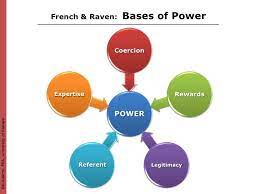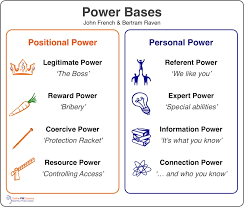The ability to understand and use influence to create motivation in others is a fundamental skill that sets successful leaders apart. Effective leaders have a clear understanding of the different sources of influence that drive human behavior and they know how to use them to create motivation. Reflecting on one’s experiences can provide valuable insights into the various sources of influence that drive actions. Please take a couple of moments to recall instances when you found yourself completing a task based on distinct motivating factors.
- Think of a time when someone asked you to do something, and you did it because you liked or admired that person.
- Think of a time when someone asked you to do something, and you did it because the person offered you something you valued in return for completing the task.
- Think of a time when someone asked you to do something, and you did it because the person had the authority over you to demand you do what the person asked.
- Think of a time when someone asked you to do something, and you did it because the person was an expert in the thing the person asked you to do.
- Think of a time when someone asked you to do something, and you did it because you were afraid something negative would happen to you if you didn’t.
Now that we’ve stirred up some memories, it becomes clear that influence comes from multiple facets of our relationships and social dynamics. French and Raven’s Power Base Taxonomy presents an invaluable framework that allows us to dissect the sources of power individuals utilize to influence and create motivation in others. In the following, we will identify and discuss the five power bases, explain how each base is used to create motivation, and discuss research findings into each base’s effectiveness.
The five power bases

- Legitimate Power: This power base comes from a person’s position or title within an organization.
- Reward Power: This power base comes from the ability to give rewards, such as bonuses or promotions.
- Coercive Power: This power base comes from the ability to give punishments.
- Expert Power: This power base comes from having knowledge or expertise in a particular area.
- Referent Power: This power base comes from being respected or admired by others.
Tying the power bases to influence and motivation
Now that we’ve identified the power bases, let’s talk about how they tie into influence and motivation. Influence is the ability to persuade or affect someone’s behavior or decisions, while motivation is the drive to take action. Each power base has a different way of influencing, which creates motivation in others:
- Legitimate Power: This power base can influence and create motivation in others based on the supervisor’s authority. For example, a supervisor has the ability to give orders and the employee has the responsibility to follow the orders given based on the supervisor’s authority.
- Reward Power: This power base can influence and create motivation in others by offering incentives for achieving goals and recognizing hard work. The key to reward power is the person who is offered the reward must value it. If not, the reward may not create motivation in the person to complete the task.
- Coercive Power: This power base can influence and create motivation in others by creating fear of negative consequences (or discipline) for not meeting expectations or following through with the order(s) given.
- Expert Power: This power base can influence and create motivation in others by providing guidance and mentorship based on knowledge and expertise.
- Referent Power: This power base can influence and create motivation in others by setting an example of behavior and inspiring others to follow their lead. Think about a great coach or great boss/leader you have had. You will walk through fire for those that hold referent power with you.
Research findings concerning the effectiveness of the power bases

Research has shown the most effective power bases for positively influencing and motivating others are referent power and expert power. Studies have revealed that leaders who actively cultivate and possess referent power have a remarkable impact on their teams. They emerge as genuine role models, build trust, and attract admiration through their personal qualities like honesty and integrity. Leaders that nurture referent power can shape a positive and inspiring organizational culture, fuel motivation, and foster a strong sense of loyalty among their followers. Concerning expert power, studies have shown that followers perceive expert power leaders as competent and trustworthy. Consequently, their followers exhibit elevated levels of motivation and commitment. To illustrate, let’s delve into a study conducted among nurses and their supervisors. The results revealed that nurses working under supervisors with significant levels of expert power reported higher job satisfaction and greater commitment to the organization. It’s clear that when leaders actively demonstrate their expertise, it has a profound impact on the engagement and dedication of their team members.
Anecdotally, I have conducted an exercise that explores behaviors associated with good and bad leaders in training and university settings with over 2,000 people. The exercise identifies the power bases the behaviors demonstrate. The result of the exercise is always the same, the referent and expert power bases are associated with good leaders while poor leaders rely on legitimate and coercive power bases.
I must note that while the referent and expert power bases are considered the most effective in fostering positive influence and motivation, leaders must actively comprehend all the power bases. They need to consciously choose the suitable power base(s) to influence and motivate based on the follower and the specific situation at hand. By understanding the dynamics of each power base, leaders can skillfully navigate the complexities of their role, ensuring optimal influence and motivation for their team members.
Use the power of influence to inspire, lead, and make a positive impact
Influence and motivation, guided by French and Raven’s Power Base Taxonomy, hold the key to exceptional leadership. By understanding the five power bases within the taxonomy – legitimate, reward, coercive, expert, and referent – we gain invaluable insights into how leaders leverage these power bases to create motivation and inspire action. Each power base possesses its own unique way of influencing others, whether it’s through authority, rewards, consequences, expertise, or respect and admiration. Armed with this knowledge we can grow and improve as a leader. Remember, your influence matters. Unleash the power of influence, inspire and create motivation in others, and make a lasting impact!
